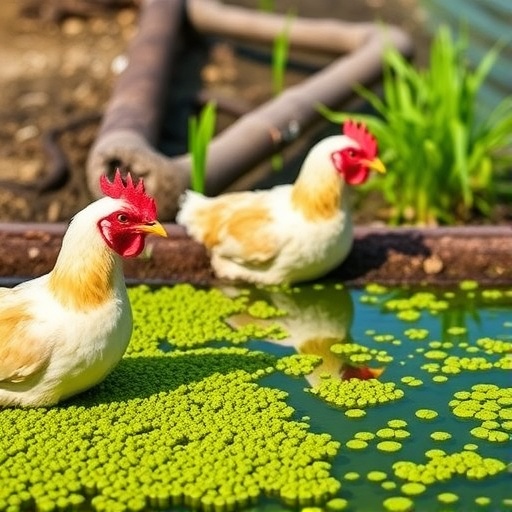Recent developments in the field of wastewater management indicate a promising integration of biological treatments using photobioreactor systems. A compelling study led by researchers from Spain explores the kinetics of biological treatment of poultry slaughterhouse wastewater through the innovative use of microalgae, specifically Nannochloropsis oculata. This research highlights a sustainable strategy for the valorization of agro-industrial effluents—a significant concern for poultry processing facilities globally.
Poultry slaughterhouses generate vast amounts of wastewater, often laden with nutrients, organic matter, and pathogens. Traditional treatment methods can be inefficient and costly, leading to environmental concerns. The integration of microalgae into wastewater treatment presents a dual benefit: it not only aids in the purification of water but also allows for the potential harvesting of biomass, which can be repurposed into various high-value products. Nannochloropsis oculata is lauded for its rapid growth rates and high lipid content, making it an optimal candidate for such applications.
The empirical investigation conducted by Sales-Pérez and colleagues uses photobioreactors to assess the efficiency of Nannochloropsis oculata in treating wastewater from poultry slaughterhouses. Photobioreactors are closed systems designed to provide a controlled environment for the growth of photosynthetic organisms, ensuring optimal conditions for both light and nutrient availability. Such systems can significantly enhance the biological treatment process compared to open pond systems, particularly in terms of biomass production and nutrient removal.
A key focus of the study is the kinetic analysis of the treatment process, which evaluates how effectively Nannochloropsis oculata can assimilate nutrients and degrade organic matter present in the wastewater. Kinetic parameters, including growth rates, nutrient uptake rates, and lipid accumulation, were meticulously monitored to derive valuable insights into the operational efficiency of the photobioreactor systems. The results are expected to elucidate optimal operating conditions that maximize both bioremediation and biomass production.
One of the noteworthy findings from the study is the microorganism’s ability to thrive under varying nutrient concentrations typically present in poultry wastewater. This resilience indicates that Nannochloropsis oculata could be harnessed in a range of wastewater treatment scenarios, adapting to the fluctuating effluent characteristics observed in industrial settings. Moreover, the metabolic pathways utilized by the microalgae facilitate not only remediation efforts but also the potential synthesis of biofuels and nutraceuticals, thereby creating a circular economy approach to waste management.
The researchers also conducted rigorous trials to ascertain the optimal light intensity and photoperiod for microalgal growth within the photobioreactors. Light is a crucial component of photosynthesis, and varying its intensity has direct implications on the growth efficiency and lipid accumulation in microalgae. Phase-shift experiments revealed that a balance between light availability and nutrient loading is vital to sustaining a profitable microalgae cultivation system for wastewater treatment purposes.
Furthermore, the challenges of contaminant removal in slaughterhouse wastewater were addressed in the context of fluctuating operational parameters. The adaptability of Nannochloropsis oculata under stress conditions associated with high organic loads showcases not only its resilience but also enhances the economic viability of using biologically-driven processes for wastewater treatment. This research posits that maintaining consistent operational conditions can yield an organic waste processing system that aligns with both environmental sustainability and economic efficiency.
Beyond the findings related to waste treatment, there are significant implications for the poultry industry in terms of regulatory compliance and corporate responsibility towards environmental stewardship. As awareness of sustainable practices grows, the adoption of microalgal systems may become increasingly relevant, mitigating the adverse effects typically associated with poultry waste disposal.
In conclusion, this study sheds light on a transformative approach to managing poultry slaughterhouse wastewater through the integration of Nannochloropsis oculata in photobioreactors. By demonstrating the effectiveness of biological treatments, the research underscores the potential for reclaiming nutrients and generating biomass, thereby contributing to sustainable agro-industrial processes. Future investigations could further refine these systems, exploring scaling possibilities and long-term operational dynamics that enhance productivity while minimizing environmental impacts.
As industries worldwide seek innovative solutions to combat pollution and resource depletion, the findings from Sales-Pérez et al. stand as a beacon of hope. They illustrate the intrinsic potential of biological systems to support animal agriculture and pollution management, inspiring a new wave of research and application aimed at creating a greener, more sustainable future.
Subject of Research: Kinetics of Biological Treatment of Poultry Slaughterhouse Wastewater
Article Title: Kinetics of Biological Treatment of Poultry Slaughterhouse Wastewater in Photobioreactors Operated with Nannochloropsis oculata: A Strategy for the Valorization of Agro-Industrial Effluents
Article References: Sales-Pérez, R.E., Estrada-García, J., Hernández-Martínez, J.M. et al. Kinetics of Biological Treatment of Poultry Slaughterhouse Wastewater in Photobioreactors Operated with Nannochloropsis oculata: A Strategy for the Valorization of Agro-Industrial Effluents. Waste Biomass Valor (2025). https://doi.org/10.1007/s12649-025-03415-9
Image Credits: AI Generated
DOI: https://doi.org/10.1007/s12649-025-03415-9
Keywords: poultry wastewater, Nannochloropsis oculata, photobioreactor, biological treatment, nutrient recovery, sustainable agriculture, circular economy




